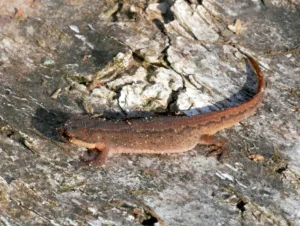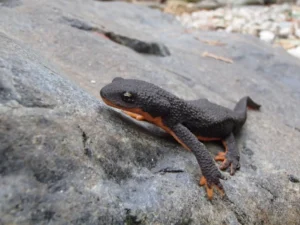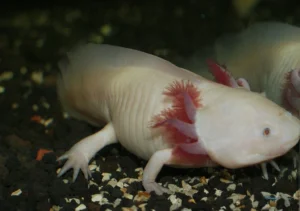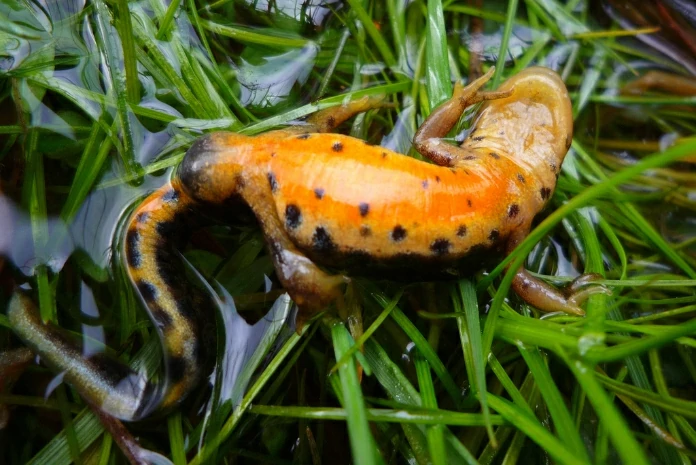Newts are really interesting animals. If they lose a leg, tail, or even parts of their heart or eyes, they can grow them back. It’s kind of like magic, especially when you think about how humans can’t do anything close to it. But can newts actually regrow limbs?
Yes, newts can regrow their limbs. They can regenerate lost legs, tails, eyes, heart tissue, and even parts of their spinal cord multiple times throughout their lives. Adult newts take about 40 to 60 days to fully regrow a limb, and they can do this over and over without losing the ability.
Most frogs and toads lose this power when they change from tadpoles into adults. Newts? They keep it their whole lives.
How Newts Regrow Their Limbs
When a newt loses a limb, something amazing happens. The cells near the cut don’t just make a scab like ours do.
Instead, they sort of “reset” and become blank cells that can turn into whatever the body needs. Scientists call this dedifferentiation.

Young newts mostly use stem cells, which are just cells that haven’t picked a job yet.
Adult newts make their muscle and bone cells go backwards and turn them into building blocks for new tissue.
These cells gather at the wound and form something called a blastema.
Think of it like a lump of clay the body can shape into a new limb.
Bones grow, muscles form, nerves connect, and skin covers everything. It usually takes 40 to 60 days for adult newts.
Why We Can’t Do This
You might wonder why humans can’t do this. Well, when we get a cut, our body rushes to close it fast.
It forms scar tissue, which is tough, but it can’t turn into muscle or bone. The body chooses speed over making a perfect copy.
Newts are different. Their cells can reverse their job and become flexible again.
Scientists think this might be a hidden ability in humans too, but our bodies shut it down early to keep us safe from infection and losing blood.
What Body Parts Can Newts Regrow?
Limbs aren’t the only things newts can rebuild. They’re basically walking repair kits.
If a newt loses its tail, it grows back. If its eye gets damaged, it can rebuild the lens and even parts of the retina.

Research has shown they can even regrow big parts of their heart and spinal cord.
This means a newt can survive injuries that would seriously hurt or kill most other animals. A damaged heart? They fix it. A severed spinal cord? They reconnect it.
Even better, newts can do this multiple times. Cut off the same leg twice, and they’ll grow it back twice. The process doesn’t wear out as they get older.
How Long Does It Take For a Newt to Regrow a Limb?
How fast a limb grows back depends on the newt’s age and size. Younger, smaller newts regrow limbs faster than older, bigger ones.
A young newt might regrow a leg in about 40 days. Adults usually take 40 to 60 days. Some bigger species can take 100 days or more.
Compare that to humans. If we could regenerate at the same speed as newts, it would take 15 to 20 years to grow a full limb. Not very practical, right?
The process happens in stages. First, the wound closes and the blastema forms (about 7 to 10 days).
Then the blastema grows and starts shaping into a limb (about 20 to 30 days). Finally, the limb matures and works fully (another 10 to 20 days).
The Role of Nerves in Limb Regeneration
Newts need nerves to regrow limbs. If you cut off a newt’s leg and also remove the nerves leading to it, the limb won’t grow back properly.
Nerves don’t just carry signals for movement and feeling. They also send out chemicals that tell the cells to start rebuilding.
Without these signals, the blastema won’t form correctly.
Studies show that the amount of nerve tissue matters too. Small injuries might grow back with fewer nerves, but big ones need a good nerve supply to heal completely.
This is one reason why human limb regeneration is so tricky. Even if our cells could reverse their job like newts’ cells, we’d also need to copy the nerve signals that guide the process.
Can Other Animals Regrow Limbs Like Newts?
Newts aren’t the only animals that can do this, but they’re some of the best. All salamanders can regrow parts of their body.
Axolotls, which are a type of salamander, are really famous for it.

Some lizards can regrow their tails, but the new tail isn’t the same as the original. It has cartilage instead of real bone, and it doesn’t have the same muscles.
Starfish can regrow arms, and some can even grow a whole new body from one arm.
Flatworms can rebuild from tiny pieces of themselves. But among animals with backbones, salamanders are the champions.
Frogs and toads can regrow limbs as tadpoles, but they lose this power as adults. Newts are special because they keep this ability for life.
What Scientists Are Learning From Newts
Scientists study newts to see if humans could ever regrow limbs.
Research shows that even old, damaged cells can help with regeneration by sending out special growth signals.
They’ve also found many of the genes and proteins that help newts regrow limbs. Humans have some of these too, but they’re turned off or work differently.
The tricky part is turning these processes on in humans without causing problems like cancer. Uncontrolled cell growth is basically what cancer is.
Some researchers think we might not copy newts exactly. Instead, we could use what we learn to help people regrow fingers or fix hearts, even if we can’t grow whole limbs.
Do Newts Feel Pain When They Lose a Limb?
A lot of people wonder about this. Newts do have nerve endings and can sense damage, but we don’t know exactly how they feel pain.
What we do know is newts survive limb loss all the time. They get attacked by predators, caught in accidents, or injured in fights with other newts.
The fact that they survive and keep living shows it probably isn’t too harmful.
Their bodies seem made for this. The regeneration starts right away, and newts keep eating, moving, and living normally while they grow back lost parts.
Still, if you keep newts as pets, never hurt them or test their ability. Just because they can regrow something doesn’t mean losing it isn’t stressful or harmful.
Conclusion
Newts can absolutely regrow their limbs, and they can do it multiple times in their lives. This comes from their cells’ ability to reverse their job and turn back into building blocks that can form any tissue.
The process takes about 40 to 60 days in adults, and it works for limbs, tails, eyes, heart tissue, and even parts of the spinal cord.
Scientists keep studying newts to understand how this works, hoping one day we might use these lessons to help people.
For now, newts are one of nature’s most amazing examples of body repair.
They show us that regrowing lost parts isn’t impossible, it just needs the right cells and the right conditions.
Hi, my name is Ezra Mushala, i have been interested animals all my life. I am the main author and editor here at snakeinformer.com.

